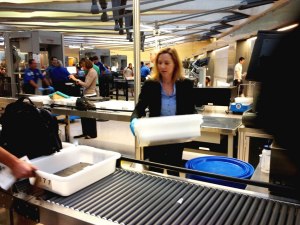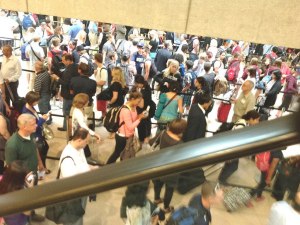By Barbara S. Peterson, Condé Nast Traveler
Although the TSA is set to expand its popular PreCheck fast lanes this fall, the agency is under pressure to speed up screening for even more fliers, so all aspects of the checkpoint experience are being scrutinized. However, there's one culprit that isn't going away anytime soon: bin gridlock. Simply put, it's too many bins piling up on the other side of the detector, and not enough hands to move them off the conveyor belt. The TSA frequently has to call in extra help to keep bins moving during busy times. To get a closer look at this oft-overlooked side of security, I spent an afternoon earlier this summer at Dulles Airport as a volunteer bin-pusher.

The bin back-up can get so bad that the TSA has to pull non-screener staff away from desk jobs just to move the containers along--they simply don't have enough officers to handle inspections and housekeeping chores. And bin-lackey duties don't require any special training or certification (unlike the several weeks of training I did receive for my part-time screener stint six years ago. All it requires is some latex gloves and being fast on your feet. [For the record, my previous experience with TSA had no connection to this assignment.]
As it happens, volume at the airport that afternoon was busier than on a normal day, and by 3 p.m., the lanes were swelling. The posted wait times at the checkpoint, less than 15 minutes when I arrived an hour earlier, had doubled to 30. (Dulles is the first airport in the U.S. to display real-time waits.)
Conveniently, Dulles checkpoints have a spacious refresh zone so passengers can pull themselves together before leaving security; but that's really just a zone for losing things.

Experienced screeners say on a typical shift during rush hour, frantic fliers routinely leave behind belts, watches, and harder-to-replace items like laptops, cell phones, car keys--even boarding passes. A main fringe benefit for fliers signing up for PreCheck is that they get spared the security striptease: They get to keep shoes and jackets on and even leave their laptops in their carry-ons, and thus are less likely to have to pay a visit to the TSA lost and found.
But for the rest of the flying public, things could get worse, as airline fees inspire more fliers to haul their belongings through the checkpoint.
In the space of just one hour, the left-behind loot I picked up included: 1 passport, 2 laptops, 1 wallet, 1 belt, 1 boarding pass, and an airport parking lot ticket. And loose change: I didn't count it, but consider that the TSA last year collected more than $500,000 worth of errant nickels, dimes, and quarters nationwide; the money goes back to TSA coffers and is used for general security purposes, although some lawmakers argue it should be donated to charity.
There's also a sizable trove of items that aren't claimed, as well as a locker labeled "VAP," for voluntarily abandoned property, such as Swiss Army knives that many travelers simply surrender, given the lack of good alternatives (going back to the terminal to check it as baggage is clearly not an option for anyone in a hurry.) And as you may have heard, that trove is divvied up among states who can dispose of it at auction or even on eBay.